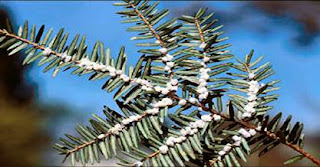Fighting the Hemlock Woolly Adelgid
The workshop will be held on Tuesday, March 25, 2014, from 6:30 to 9:00 p.m. at the University of Pittsburgh-Bradford, Fisher Hall Room 107. The training will take place at 300 Campus Drive, Bradford, Pennsylvania. The workshop will feature presentations by Dale Luthringer of DCNR about eastern hemlock values and threats, by Rick Turcotte of US Forest Service on the adelgid’s biology and the threat it poses to local hemlock forests, and by Sarah Johnson of The Nature Conservancy on the High Allegheny Plateau Conservation Strategy. Participants will gain experience in detection, monitoring, and reporting protocols for hemlock woolly adelgid. Participants will also have the opportunity to volunteer in the “Adopt-a-Hemlock” program to conduct surveys and report new infestations in local hemlock forests.
This newly arrived invasive insect threatens eastern hemlock trees and the biodiversity they support in the Allegheny National Forest, and in Pennsylvania and New York State Forests, Parks, and Game Lands.
This destructive pest, introduced from Asia, was detected in Cook Forest and Clear Creek State Parks in the spring of 2013, and in locations on the Allegheny National Forest, including the Clarion River, Allegheny River, Webb’s Ferry, and the Tionesta Research Natural Area. Tionesta Research Natural and Scenic Areas represent one of the only remaining patches of the original six million acre forest that once covered the Allegheny Plateau. Together, they comprise over 4,000 acres of remnant, original forest and are considered the largest contiguous old growth area between the Adirondacks and the Great Smokey Mountains. HWA has been in the northeastern United States since the 1950s and was found in southeastern Pennsylvania in the 1960s. It has recently spread to northwestern Pennsylvania.
Early detection of new sites is a high priority, and organizing volunteer surveys as a critical first step in managing this destructive invasive species in northwestern Pennsylvania and on the Allegheny Plateau. Most of northwestern Pennsylvania remains the only part of the state that does not have known hemlock woolly adelgid infestations.




.jpg)

Comments